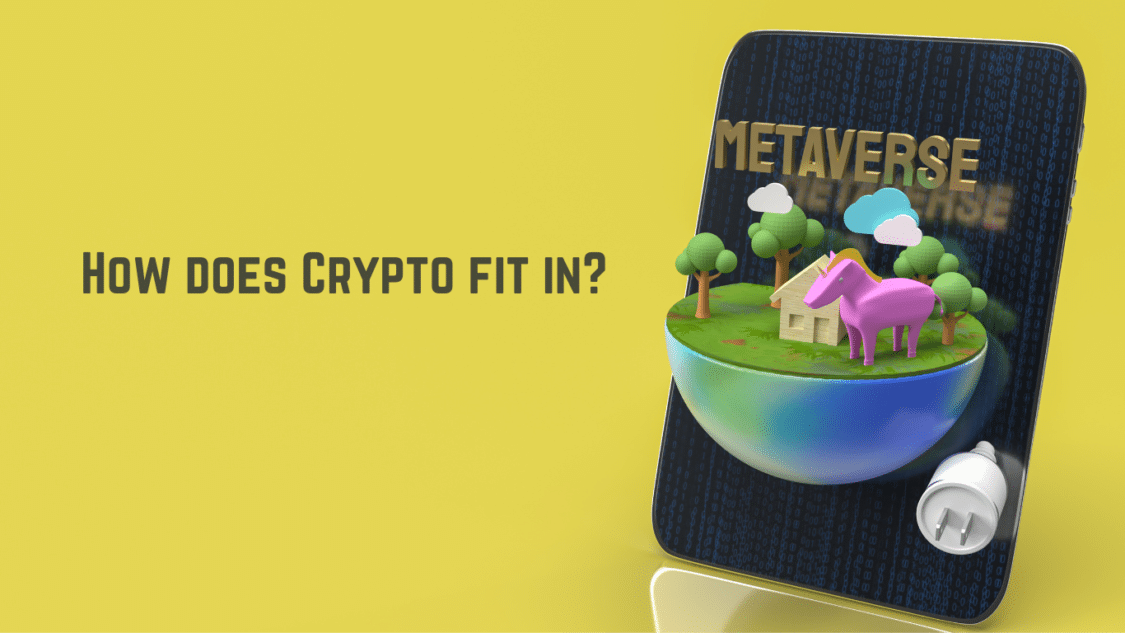The Metaverse is a new concept of an online 3D universe combining various virtual spaces. It can be explained as the future iteration of the internet. It will allow users to perform daily activities in these 3D spaces. People can do activities such as working, meeting, gaming, and socializing in different manners. It isn’t entirely in existence as of right now, but there are specific platforms that contain Metaverse-like elements. Video games are currently the closest it gets to the Metaverse experience.

Although this is unnecessary, Cryptocurrency is a great addition to the Metaverse. It will allow users to benefit from using crypto wallets such as Trust Wallet and MetaMask. The blockchain technology included in the system will allow for a reliable governance system. Metaverse-like applications are currently used by many and provide them with liveable incomes. Axie Infinity, SecondLife, and Decentraland are all examples that manage to combine the blockchain world and virtual reality apps successfully. A look into the future can bring us to the reality that big tech chains are leading the way. The decentralized aspects of the blockchain industry allow smaller players to participate in developing the Metaverse.
What is its definition?
As mentioned above, it is a new online 3D concept connecting users in all aspects of life. Like the internet, it will be able to connect various platforms through a single browser. The Metaverse was developed by the science fiction novel Snow Crash by Neal Stephenson. While the idea started as fiction, it now seems like it can be a reality in the near future.
How does Crypto fit into Metaverse?

The 3D aspect is accomplished through the gaming offered, but that doesn’t cover everything needed in a virtual world. Crypto can offer other key parts such as proof of ownership, transfer of value, governance, and accessibility. If this becomes the new reality in the future, we will work, socialize, and even purchase through the Metaverse; therefore, we will need a secure way of showing ownership. We need to feel ensured when transferring items and money, and we will want to be part of the decision-making process.
Crypto can also play a significant role by providing a way to incentivize and reward users for their contributions. In a Metaverse context, users can give to the platform’s development by creating virtual content or participating in governance. By leveraging cryptocurrency and blockchain technology, they can develop a system of incentives and rewards that encourages users to contribute and build the platform. Moreover, crypto can also provide a way to create and maintain a robust economy within this virtual reality world. As users spend time in the Metaverse, they may earn tokens or other forms of cryptocurrency that can be used to purchase virtual goods and services.
Overall, crypto and blockchain technology can play a significant role in the development and overall success of the Metaverse. By providing a few key features, such as proof of ownership, transfer of value, governance, accessibility, incentives, and economy, this can become a thriving digital ecosystem where users can work, socialize, and interact in previously impossible ways. As the Metaverse continues to develop, crypto and blockchain technology will likely become even more integrated and necessary to its functioning.
Benefits of the Metaverse
The metaverse can potentially increase access to education, entertainment, and socialization for people who may not have that in the physical world. The metaverse can likely create new economic opportunities, such as virtual real estate, digital fashion, gaming etc.
Additionally, it could provide new tools and platforms for creative expression, allowing artists and designers to explore new forms of the show and tell and interactive experiences. Lastly, it could make collaboration among individuals and teams more efficient across geographical boundaries. They are making it easier to work on projects and share ideas worldwide.
Drawbacks of the Metaverse
The metaverse could potentially lead to addiction and social isolation, as people may become too immersed in the virtual world. This will lead many to spend less time interacting with the physical world and performing daily activities.
Like any online platform, security and privacy concerns should also be considered. A user’s personal information and virtual assets could be at risk. It could worsen existing inequalities. Many cannot afford the necessary technology or internet access making them feel they are missing out on a unique experience. The rise of the metaverse could have real-world economic impacts, as the shift to virtual experiences may disrupt industries such as retail and tourism.
Properties of blockchain that make it suitable for the Metaverse:

- A digital proof of ownership: Blockchain technology allows users to prove ownership of digital assets instantly and securely. Private keys are used for confirming ownership and signing transactions. The Metaverse can ensure that virtual assets are owned and controlled by their real owners.
- Digital collectability: In a Metaverse context, digital collectibles such as virtual art, clothing, and accessories can be a valuable thing. Blockchain technology can verify these collectibles as original and unique. This provides a way for users to prove ownership and authenticity, adding value and scarcity to virtual items.
- Transfer of value: If users pass time by earning money, they will need a reliable way to transfer value. Blockchain technology provides a trustable and efficient way to transfer value without intermediaries or centralized authorities. By leveraging blockchain technology, the Metaverse can facilitate seamless and secure user transactions using a reliable and widely accepted currency.
- Governance: As it develops and evolves, it will need a way to control rules and ensure proper management. Blockchain technology provides a proven method of implementing decentralized governance, where decisions are made through a consensus mechanism, and stakeholders have a say in the direction of the platform. The Metaverse can ensure its governance is transparent, secure, and decentralized by leveraging blockchain technology.
- Accessibility: Creating a wallet on a public blockchain is open to the public, a reliable way to manage finances and digital identity. This is especially important for the Metaverse, which aims to provide an inclusive and accessible platform for users. It can offer a reliable and secure infrastructure for managing digital assets without the need for traditional financial institutions.
- Decentralization: Blockchain is a decentralized technology not controlled by anyone. Regarding the Metaverse, it allows for a more open and democratic system where users can own their virtual assets and have control over their personal data.
- Immutability: Blockchain is immutable. Once the data is recorded on the blockchain, it cannot be touched. This is important because it provides a secure and transparent system. This way, virtual assets can be verified and authenticated without a centralized authority present.
- Interoperability: Blockchain can facilitate interoperability between different platforms and virtual worlds, allowing for easy movement of assets and data between different environments. On the Metaverse, this allows for an interconnected and expansive virtual world where users can smoothly move between different experiences. Blockchain technology is continually working to improve its compatibility with different platforms. Metaverse will need to connect various projects; blockchain is just the solution.
- Security: Blockchain is a secure technology that uses cryptography and consensus mechanisms to protect data and transactions. For the Metaverse, this keeps virtual assets protected from any hacks or theft.
- Transparency: Blockchain is a transparent technology that allows users to view and verify transactions and data on the network. This is important, as it boosts trust and accountability between users and platforms.
Closing Thoughts
In conclusion, the Metaverse represents a new front to a digital experience that has the potential to alter the way we interact with technology, each other, and the world around us. Combining the elements of gaming, social media, and virtual reality, we see that it offers a new form of interactive and engaging digital experience.
As this technology continues to develop, evolve and become popular, we will likely see new and innovative use cases emerge. In addition to new challenges and opportunities. However, with the help of emerging technologies such as blockchain and cryptocurrency, we can build a Metaverse that is secure, transparent, and accessible to all. The Metaverse is a new frontier in digital experience, and the possibilities for innovation are endless.
The Metaverse is a shift in the way we interact with the world around us. As our lives are increasingly digitized, the Metaverse introduces a new form of connection and engagement. It can transform the way we learn, work, and play by creating an immersive, interactive, and engaging digital ecosystem. It is a frontier that can push the boundaries of what is possible and create a new era of creativity. We will encounter new challenges and obstacles as we continue exploring this new world. Still, with the proper approach and technology, we can build an inclusive, equitable, and beneficial place for everyone.




